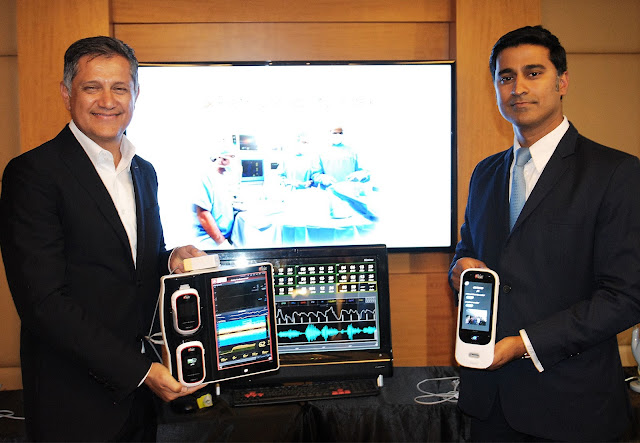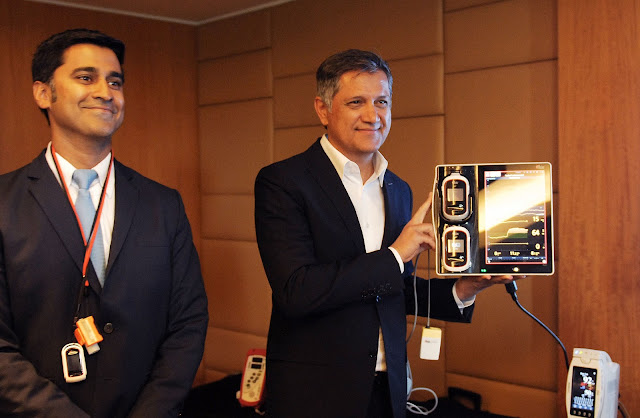Masimo Reaffirms Commitment to India with Launch of Advanced Monitoring Technologies Made for India
Leading Bangalore Hospital CEOs Convene for Masimo Roundtable

Photo Caption
1. L-R : Mr. Joe Kiani, Founder and CEO, Masimo and Bharat Monteiro, Masimo Country Manager for India, launched their new range of medical device at the press conference held today.
Bangalore, India – January 2, 2017 - Masimo (NASDAQ: MASI) announced today the launch and availability of the Rad-97™ Pulse-CO Oximeter®* and Next Generation Sedline®* Brain Function Monitoring in India. The announcement was made in Bangalore by Joe Kiani, Founder and CEO of Masimo, at a roundtable of the CEOs of top Bangalore hospitals.

Joe Kiani, Founder and CEO, Masimo, commented, “The Indian healthcare sector recognizes the need for technologies that help their clinicians get the best results, the first time. Masimo’s noninvasive patient monitoring technology innovations offer capabilities that have never been possible before. With a large population and a burgeoning demand for an improved quality of life – including the safe, high-quality healthcare to which all are entitled – India continues to be a focus market for Masimo. We will continue to invest in India and strive to make our technologies and products as accessible as possible, as evidenced by the new Rad-97 and Next Generation SedLine.”
Bharat Monteiro, Masimo Country Manager for India, noted, “Masimo is committed to doing what is best for patient care in India. In the course of our engagement with leading Indian hospitals, we have witnessed an increased awareness of and commitment to patient safety requirements. Medical providers across the country are eager to adopt advanced technologies and monitoring devices, such as Rad-97 and Next Generation SedLine, which we hope will help provide access to better healthcare, at lower cost.”
Dr. Ashutosh Raghuvanshi, Managing Director and Group CEO of Narayana Health Hospitals, one of the participants in the roundtable, commented, “We constantly endeavor to improve the facilities at our hospitals to ensure better patient care and treatment outcomes. With the newly launched Rad-97, we will be able to use Masimo SET® pulse oximetry in more care areas, including ward monitoring, which will help facilitate better monitoring and patient treatment. Narayana Health performs the highest number of cardiac surgeries in India, and I believe that noninvasive hemoglobin (SpHb) will add immense value to complex cardiac surgeries, helping us reduce unwarranted transfusions and the risk of infection.”
Rad-97 features Measure-through Motion and Low Perfusion™ SET® pulse oximetry, which studies have shown helps clinicians reduce severe retinopathy of prematurity in neonates,1 improve CCHD screening in newborns,2 and, when used for continuous monitoring in post-surgical wards, reduce rapid response activations and costs.3,4,5 Rad-97 also offers the same upgradeable rainbow SET™ technology as the Radical-7® Pulse CO-Oximeter, in a versatile, standalone monitor configuration. Using Rad-97, clinicians can monitor such rainbow® measurements as total hemoglobin (SpHb®) and PVi®. Studies with SpHb have shown reductions in unnecessary blood transfusion†,6,7 and when used with PVI, reductions in length of hospital stay8 and 30- and 90-day mortality.9 rainbow® can also measure methemoglobin (SpMet®), acoustic respiration rate (RRa®), carboxyhemoglobin (SpCO®), Oxygen Reserve Index™* (ORi™), and oxygen content (SpOC™). Rad-97 also features an integrated camera* for clinician tele-presence via Patient SafetyNet™‡ and a high-resolution 1080p HD color display with user-friendly multi-touch navigation, similar to Root® and Radical-7, allowing clinicians to easily customize the device to best suit their monitoring needs.
SedLine features four simultaneous EEG leads to enable continuous assessment of both sides of the brain, as well as a Density Spectral Array (DSA), an easy-to-interpret, high-resolution display of bi-hemispheric activity. Next Generation SedLine enhances Masimo’s processed EEG parameter, the Patient State Index (PSI), to make it less susceptible to electromyographic (EMG) interference and to improve performance in low-power EEG cases.
@MasimoInnovates | #Masimo | #0X2020
*Rad-97, the camera feature, Next Generation SedLine, and ORi do not have 510(k) clearance and are not available in the U.S.
†Clinical decisions regarding red blood cell transfusions should be based on the clinician’s judgment considering, among other factors: patient condition, continuous SpHb monitoring, and laboratory diagnostic tests using blood samples.
‡The use of the trademark SafetyNet is under license from University HealthSystem Consortium.
References
1. Castillo A et al. Prevention of Retinopathy of Prematurity in Preterm Infants through Changes in Clinical Practice and SpO2 Technology. Acta Paediatr. 2011 Feb;100(2):188-92.
2. de-Wahl Granelli A et al. Impact of pulse oximetry screening on the detection of duct dependent congenital heart disease: a Swedish prospective screening study in 39,821 newborns. BMJ. 2009;338.
3. Taenzer AH et al. Impact of Pulse Oximetry Surveillance on Rescue Events and Intensive Care Unit Transfers: A Before-And-After Concurrence Study. Anesthesiology. 2010; 112(2):282-287.
4. Taenzer AH et al. Postoperative Monitoring – The Dartmouth Experience. Anesthesia Patient Safety Foundation Newsletter. Spring-Summer 2012.
5. McGrath SP et al. Surveillance Monitoring Management for General Care Units: Strategy, Design, and Implementation. The Joint Commission Journal on Quality and Patient Safety. 2016 Jul;42(7):293-302.
6. Ehrenfeld JM et al. Continuous Non-invasive Hemoglobin Monitoring during Orthopedia Surgery: A Randomized Trial. J Blood Disorders Transf. 2014. 5:9. 2.
7. Awada WN et al. Continuous and noninvasive hemoglobin monitoring reduces red blood cell transfusion during neurosurgery: a prospective cohort study. J Clin Monit Comput. 2015 Feb 4.
8. Thiele RH et al. Standardization of Care: Impact of an Enhanced Recovery Protocol on Length of Stay, Complications, and Direct Costs after Colorectal Surgery. JACS (2015). doi: 10.1016/j.jamcollsurg.2014.12.042.
9. Nathan N et al. Impact of Continuous Perioperative SpHb Monitoring. Proceedings from the 2016 ASA Annual Meeting, Chicago. Abstract #A1103.



